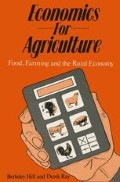Abstract
In the United Kingdom about 700 000 people, a little less than 3 per cent of the working population, are currently directly engaged in agriculture. This figure refers to those who work on farms and horticultural holdings either full- or part-time.1 Taking a broader view of what constitutes agriculture by including the service industries which depend directly on British farming (veterinary services, animal food suppliers, etc.) adds a further 246 000 (or 1 per cent of the working population). To go further and embrace the food distribution industry and tourism which are partly dependent on the activities of farms raises extreme problems of definition. Virtually all sectors of the economy are interrelated, and segmentation is not always practical for descriptive purposes nor necessary in explaining changes. Nevertheless, of the 600 000 engaged in food processing (March 1980), food distribution and retailing (187 000), machinery manufacture (60 000) and chemicals (12 000 for fertiliser alone), it has been estimated that 215 000 jobs are directly dependent on UK agriculture.2 Together this agricultural and related employment represents about 1 job in 20 for the economy as a whole.
Preview
Unable to display preview. Download preview PDF.
Notes
Rickard, S. (1982) Agriculture and employment. Paper presented to Royal Society of Arts Conference, ‘Town and Country: Home and Work’. (London: National Farmers Union). A similar estimate in
Craig, G. M., Jollans, J. L. and Korbey A. (1986) The Case for Agriculture: An Independent Assessment CAS Report No. 10 (University of Reading) gives 5.15 per cent of jobs and 4.69 per cent of whole-time equivalents as being in or related to agriculture.
Hodge, I. (1984) Rural economic development and the environment. Paper to conference of the Agricultural Economics Society, ‘UK agriculture and the environment’, 23. November 1984.
Commission of the EC (1980) The Agricultural Situation in the Community 1979 Report (Luxembourg).
Hastings, M. R. (1984) ‘Succession on farms’ J. Agric. Manpower Society (Summer). Other work on succession, see
Fennell, R. (1980) ‘Farm succession in the European Community’, Sociologica Ruralis21:1, pp. 19–42;
Thomas, H. A. (1981) ‘The need for a business approach to the problems of succession, inheritance and retirement’, Farm Management4:4, 157–62 and
Weston, W. C. (1977) ‘The problems of succession’, Farm Management3:5, 237–47.
EDC for Agriculture (1972) Agricultural Labour in England and Wales (London: National Economic Development Office).
Northfield (1979) Report of the Committee of Inquiry into the Acquisition and Occupancy of Agricultural Land Cmnd. 7599 (London:HMSO).
Newby, H. et al. (1978) Property, Paternalism and Power: Class and Control in Rural England (London: Hutchinson).
Harrison, A. (1975) Farmers and Farm Businesses in England Miscellaneous Studies No. 62, (University of Reading: Department of Agricultural Economics and Management).
Nalson, J. S. (1968) Mobility of Farm Families (Manchester University Press).
Newby, H. et al. (1978) op. cit.
Ibid.
Rettie, W. J. (1975) ‘Scotland’s farm occupiers’, Scottish Agricultural Economics 25:387–93.
Northfield (1979) op. cit.
Harrison, A. (1967) Farming Change in Buckinghamshire Miscellaneous Studies 43 (University of Reading: Department of Agricultural Economics).
Rettie, W. J. (1975) op. cit.
Hastings, M. R. (1984) op. cit.
Gasson, R. (1969) Occupational Immobility of Small Farmers, Occasional Paper No. 13 (University of Cambridge: Department of Land Economy).
Ibid.
Gasson, R. (1985) The Nature and Extent of Part-Time Farming in England and Wales. Paper to conference of the Agricultural Economics Society, ‘Farm family occupations and income’ 13 December 1985.
Gasson, R. (1983) Gainful Occupations of Farm Families (Ashfard: Wye College, School of Rural Economics).
Ibid.
Organisation for Economic Cooperation and Development (1978) Part-Time Farming in OECD Countries: General Report (Paris: OECD).
Newby, H. (1977) The Deferential Worker (Harmondsworth: Penguin).
Ibid.
Martin, P. C. (1977) ‘The age structure of Scottish farm workers’, J. Scottish Agricultural Economics 27, 87–91.
Winyard, S. (1982) Cold Comfort Farm: A Study of Farmworkers and Low Pay (London: Low Pay Unit).
Gasson, R. in Edwards, A. and Rogers, A. (1974) Agricultural Resources (London: Faber).
Pierson, R. (1978) ‘What about the farmworkers? — a trade union view’, J. Agric. Econ.29:3, 235–42.
Newby, H. (1972) ‘The low earnings of agricultural workers: a sociological approach’ J. Agric. Econ. 23:1, 15–24.
Winyard, S. (1982) op. cit.
Newby, H. (1977) op. cit.
Pierson, R. (1978) op. cit.
Ibid.
Gasson, R. (1973) ‘Goals and values of farmers’, J. Econ., 18:3, 521–42.
Ibid.
Gasson, R. (1973) op. cit.
Black, C. J. (1965, 1966) ‘Capital deployment on farms in theory and practice’, Farm Economist10: 475–84. 11: 10–23.
Burrell, A. M., Hill, G. P. and Williams, N. T. (1983) ‘Grants and Tax Reliefs as Investment Incentives’ J. Agric. Econ. 34:2, 127–38.
Harrison, A. (1975) op. cit. and
Gasson R. and Hill, Berkeley (1984) Farm Tenure and Performance (Ashford: Wye College, Department of Agricultural Economics).
Newby, H. (1977) op. cit.
Ibid.
Critchley, R. and Birse, M. (1980) ‘Job satisfaction and the farm worker’Farm Management Review 13 Aberdeen: North of Scotland College of Agriculture).
Pierson, R. (1978) op. cit.
Copyright information
© 1987 Berkeley Hill and Derek Ray
About this chapter
Cite this chapter
Hill, B., Ray, D. (1987). Resources in Agriculture: Labour. In: Economics for Agriculture. Palgrave, London. https://doi.org/10.1007/978-1-349-18782-9_7
Download citation
DOI: https://doi.org/10.1007/978-1-349-18782-9_7
Publisher Name: Palgrave, London
Print ISBN: 978-0-333-35225-0
Online ISBN: 978-1-349-18782-9
eBook Packages: Palgrave Business & Management CollectionBusiness and Management (R0)

